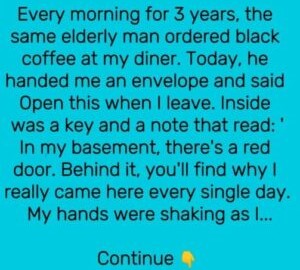The Mystery Behind His Daily Coffee Visits Will Leave You Speechless

For three years straight, without fail, he showed up at exactly 7 AM. An older gentleman, likely in his seventies, would walk into my small-town diner, quietly slide into booth number 7, and offer a gentle smile before ordering the same thing every time: “Black coffee, please.”
He never asked for food, never lingered too long. Just 30 minutes of quiet company and a view—always facing the old, worn-down factory across the street.
I never knew his name. I started calling him “Mr. Seven” after the booth he always chose. In a town like ours, regulars become part of your rhythm without ever revealing much of their story.
But today… today was different.
His hands were shakier than usual, and his eyes carried a weight I hadn’t noticed before. As he finished his coffee, he stood slowly and handed me a sealed white envelope.
“Open this after I leave,” he said softly. “And thank you, Sarah, for always getting the coffee just right.”
I froze. He had never once used my name.
Once he left, I opened the envelope with trembling hands. Inside was a brass key and a handwritten note:
“Sarah,
For three years, I’ve sat quietly trying to find the right moment to share this. At 247 Oak Street, in the basement, there’s a red door. Behind it, you’ll find the reason I came to your diner each morning. What you do with it is your choice.
— Thomas Bennett”
Curiosity and something deeper pulled me there on my lunch break. The house was quiet and well-kept, with fading blue paint and a worn path to the porch. The key turned in the lock with a satisfying click.
I found the red door just where he said—in the basement, its paint chipped and its surface aged with time.
When I opened it, I wasn’t ready for what I saw.
Hundreds of paintings filled the room. All of the same building—the old factory across from the diner. Each painting captured it from a different angle, in different seasons and light. But every one of them included a woman in a blue dress standing at the factory’s entrance.
On a nearby table, I found an old newspaper clipping dated 1973. The headline read:
“Young Teacher Dies in Factory Blaze.”
The photo showed the same building. And the same woman from the paintings.

Her name was Mary Bennett. A 23-year-old schoolteacher who lost her life trying to rescue documents from the burning factory.
I looked up and saw a wedding photo on the wall—Thomas as a young man, standing proudly beside Mary. The woman in the blue dress.
He hadn’t been coming to the diner for the coffee. He came to sit in that exact spot, with the perfect view of the building where he last saw the love of his life. And every day, he returned to paint her memory back into the world.
One unfinished painting remained on the easel. But it wasn’t of the factory—it was of my diner. Me, handing him coffee, and in the reflection of the window behind me… the faint silhouette of a woman in a blue dress.
A final note was clipped to the canvas:
“Sarah,
You reminded me of her—the way you smile, the way you listen. Mary was a storyteller, just like you. I’m too old to come back now, but I couldn’t leave without passing our story to someone who would understand. The paintings are yours. Share them, keep them, let them live on.
— Thomas”
I never saw Mr. Seven again.
But I kept that final painting. And sometimes, when the early morning light filters through the diner window, I swear I see her—Mary—smiling faintly through the glass, watching over the man who never stopped loving her.